With mobile games becoming nearly as advanced as console and PC offerings — not to mention the rise of cloud gaming — it’s no surprise we’ve seen plenty of peripherals designed to make our smartphones feel more like dedicated gaming platforms. Most of these options, however, leverage clips that awkwardly attach existing controllers to our devices or gamepads that connect via potentially laggy Bluetooth.
The Backbone One forgoes these flawed designs, offering a polished, expertly crafted option that essentially turns your iPhone into an on-the-go gaming console. Compatible with iPhone models as far back as the 6s, the Backbone’s further enhanced by a proprietary app that works seamlessly with the controller to essentially form its own gaming ecosystem. More than another throwaway companion app, the software truly complements the hardware, making the full Backbone experience an unbeatable option for those looking to level-up their mobile sessions.
Console gaming controls for your phone
The Backbone One is an excellent buy for iPhone gamers, delivering a premium controller on par with console peripherals alongside an an app that truly enhances the mobile gaming experience.
The who, what and how
Who’s it for: At $99.99, the Backbone One probably isn’t for the casual gamer who occasionally plays Clash Royale on their subway commute. But if you regularly play the likes of Call of Duty: Mobile and Genshin Impact, or use your iPhone to enjoy console and PC games – via remote play and cloud streaming services – the Backbone is a literal game-changer. There’s no Android version just yet, but Backbone has one on the way.
What you need to know: The Backbone is specifically designed for iPhones, from the 6s up to the latest models. If you’re using an iPhone 13 Pro or Pro Max, you’ll need an adapter to ensure a snug fit, but Backbone provides this accessory for free upon request. Once snapped together via the Lightning connector, the iPhone and Backbone become a unified gaming platform, feeling much like the Nintendo Switch.
How it compares: The Backbone’s closest competitor is the Razer Kishi, a similarly designed – and priced – dedicated controller for the iPhone. While the Kishi delivers console-quality controls (and comes in an Android variation), the Backbone’s design is more ergonomic, and its app more robust and better integrated.
Console-quality controls
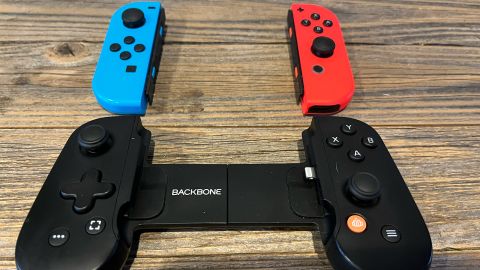

While plenty of peripherals allow you to play mobile games with console-like controllers, the Backbone feels much less like an accessory that slightly enhances the experience and more like a device designed to transform your iPhone into a portable gaming platform.
This is evident right out of the box, as the Backbone immediately feels as sturdy and solid as a console gamepad. Its namesake, which extends and telescopes between the two controllers, is the least durable part of the device – allowing for a bit of bending and bowing if you play with it too much. But once plugged into your phone’s Lightning connector – which negates the need for Bluetooth and the latency issues that can come with it – it solidly locks into place. In fact, it can’t be understated enough just how much the elegant, rigid pairing of the Backbone and iPhone evokes the build and feel of a handheld gaming device. Spend just a few minutes with it, in fact, and it’s easy to forget you’re not playing on something more akin to a Nintendo Switch or Steam Deck.
Of course, its premium inputs and ergonomic design further sell this sensation once you’ve snapped it into place. A cross between Nintendo’s Joy-Cons and an Xbox gamepad, the Backbone features all the expected buttons, thumb-sticks, bumpers, and triggers, as well as a D-pad. The button designations are the same as the Xbox controller’s A, B, X, Y layout, while its offset thumb-sticks similarly mimic Microsoft’s peripheral. That said, the buttons and sticks are smaller – more to the scale of the Switch’s corresponding inputs. Additionally, the thumbsticks’ surface is convex, also like the Switch’s, rather than recessed like an Xbox controller’s sticks.
Your mileage will vary depending on layout and design preferences – and alphabet-averse PlayStation users will have to rely on muscle memory – but regardless of what sort of controller you typically favor, you’ll appreciate the premium feel and responsiveness of the Backbone’s inputs. As someone who regularly blisters his thumbs across nearly all gaming platforms, I found the Backbone a solid substitute for a dedicated console controller. Whether grinding through Elden Ring’s harsh world, reducing Stormtroopers to piles of plastic in LEGO Star Wars: The Complete Saga, or stealthing my way through Chernobylite’s exclusion zone, the Backbone delivered. The buttons are clicky, the sticks solid, and the triggers and D-pad springy. Aside from missing the more sophisticated haptic tech of a PS5 or Xbox Series X controller, you won’t feel like you’re sacrificing much when gaming behind the Backbone.
All of your mobile games in one place
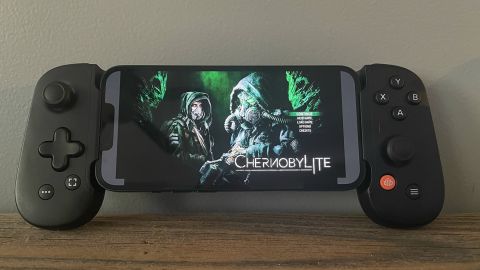

Beyond the expected tactile inclusions, the Backbone sports a headphone jack and Lightning port for pass-through charging. The latter’s an especially welcome, practical inclusion, one that occasionally kept me gaming in bed until the sun came up.
The device also houses an orange button emblazoned with the Backbone logo. This input provides the gateway to one of the controller’s best and most surprising features, the Backbone+ app. Pressing it opens the device’s interface, allowing you to access your games and services, connect with friends, and generally feel like you’re navigating a thoughtfully crafted hub not unlike those that appear when powering up a PlayStation 5 or Xbox Series X.
Streamlined and intuitive, the app immediately impresses, as you swap between your favorite games and supported services and features, from PlayStation Remote Play and Steam Link to Stadia, Xbox Cloud Gaming, Amazon Luna, Apple Arcade, and many more. Streamers and socialites will also appreciate its seamless Twitch integration, voice chat and lobbies, as well as screen and video capturing, editing, and sharing – all nicely supported by dedicated buttons located beneath the D-pad. Cool inclusions, like the Backbone button illuminating and pulsing while you’re recording footage, further demonstrate how much thought went into crafting the device.
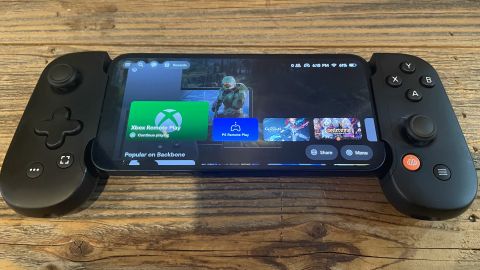

More than just supporting a ton of content and services, it’s the app’s ability to present it all in one easy-to-access place that makes it shine. As an Xbox Series X and PlayStation 5 owner, it’s pretty mind-blowing to see these console competitors sit side by side in the same interface. Utilizing both platforms’ remote play features within Backbone+ means I can swap between Sony and Microsoft exclusives, like Horizon Forbidden West and Halo Infinite, respectively, from a shared menu, in under 30 seconds. Downloading titles from the App Store, without actually having to switch between Backbone+ and Apple’s storefront, is similarly impressive. It’s pretty wild how unified it all feels.
Getting to this point of blissful cohesion does require some set-up and behind-the-scenes leg work, like signing into your various accounts, setting up remote play options on your consoles, and adding favorite games by pressing the Backbone button. But once you’ve spent 15 or so minutes laying this foundation, you’ll find Backbone+ presents the sort of home-screen experience typically reserved for consoles.
Of course, the app won’t fix bad internet or finicky cloud gaming services. My remote play sessions were mostly lag-free, but Xbox Cloud Gaming over Starbucks’ unreliable internet frequently tripped over performance hurdles. While the Backbone isn’t to blame for this, it’s worth considering if you don’t own a console and are strictly thinking of streaming games to your device via the cloud. On the other hand, the Backbone significantly enhances App Store, Apple Arcade, and remote console sessions. The tight gamepad inputs are an obvious boon for the former two services, allowing titles like Call of Duty: Mobile and Castlevania: Grimoire of Souls to be enjoyed without having to fiddle with touch controls.
I was most surprised, though, at how often I traded my next-gen consoles for the Backbone’s convenience. Whether playing on the couch while my kids hogged the TV or soaking in Chernobylite’s spooky atmosphere while tucked into bed, I found myself firing up the Backbone more frequently than my Xbox Series X and PS5. It’s a testament to its console-quality design – and latency-free Lightning connection – that I never felt I was giving anything up when choosing the Backbone over my consoles.
Bottom line
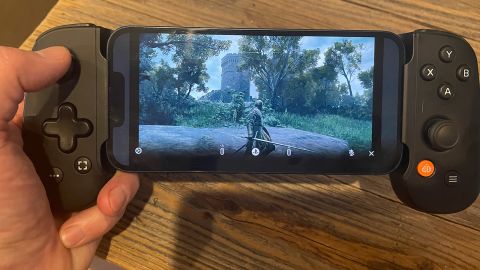

As someone who’s struggled to embrace mobile gaming’s touch controls, and had yet to find a peripheral that made remote play feel as good as gaming on a console, I found the Backbone One pretty transformative. Its solid, ergonomic design, responsive controls, and fantastic app integration have, for all intents and purposes, turned my iPhone into a new gaming platform I didn’t know I needed. For better or worse, I’m gaming more than ever with the Backbone, squeezing in sessions where I typically wouldn’t.
My biggest gripe with the device is also a bit of a complement: Because I use it so much, removing my cumbersome, two-piece protective phone case to connect it has become a regular chore. Seriously, I either need a new case that’s easier to take on and off, or a second phone to provide a permanent home for the Backbone. It’s also worth noting the Backbone doesn’t yet support Android devices, so Google smartphone owners looking to game on the go may want to check out the Razer Kishi.
Another potential issue is one that can’t be properly evaluated for another 12 months, the length of time Backbone+ is provided gratis. New Backbone adopters get the app for a year (as well as one free month of Xbox Game Pass Ultimate,) but will then be charged $49 annually. Right now, I can’t imagine using Backbone without its app, but it remains to be seen how the software will evolve and what, if any, features will be available to those who bristle at the thought of signing up for yet another subscription.
All that said, while Backbone+ certainly enhances the overall experience – especially when you’re not paying for it – the hardware itself is still an easy recommendation for anyone looking to play mobile games with console-rivaling controls or enjoy the benefits of remote play and cloud streaming.






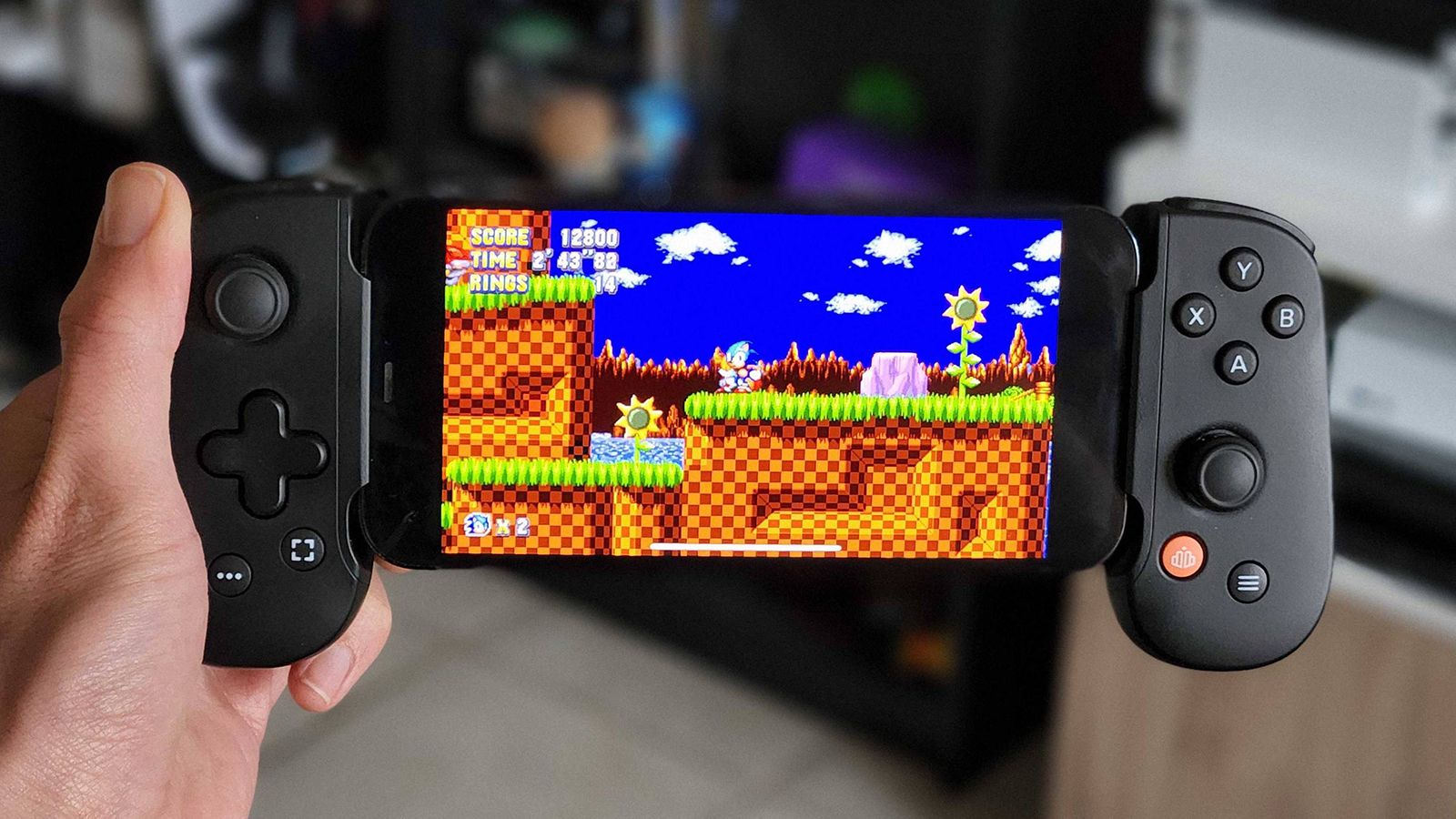
More News
Frank Stella, Towering Artist and Master of Reinvention, Dies at 87
Hats on and Off at the 150th Kentucky Derby
As States Resist Federal Gender Rules, Schools Are Caught in the Middle